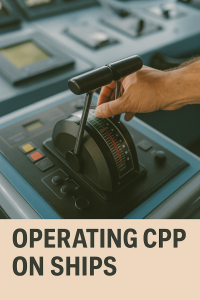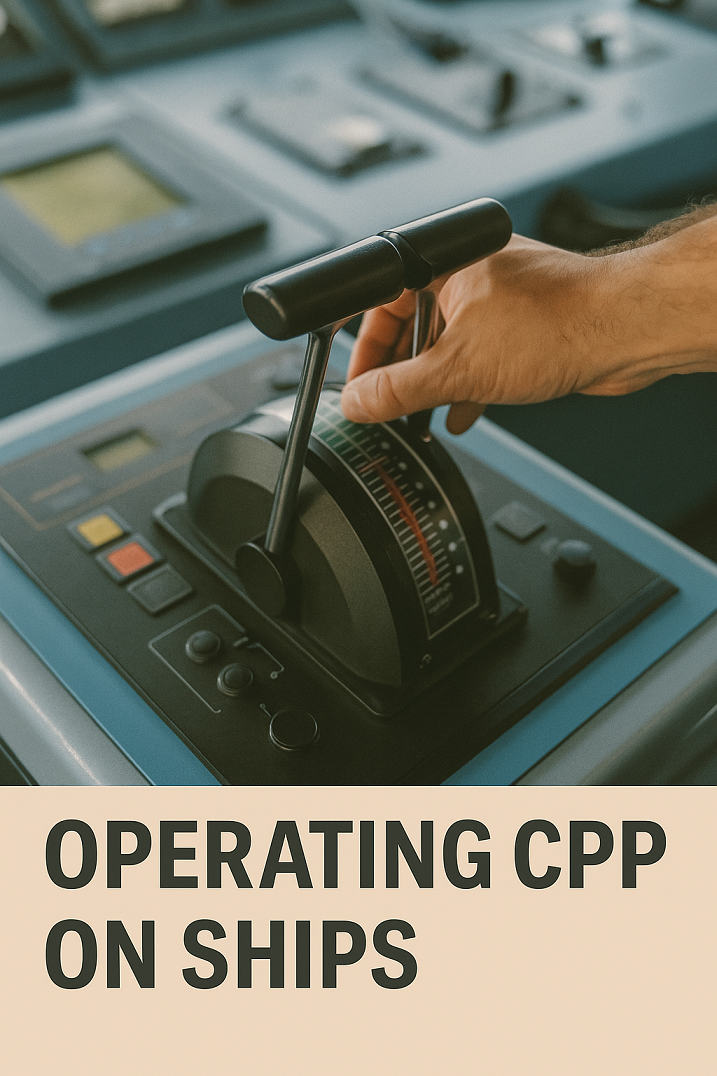 Discover the top 12 precautions before operating controllable pitch propellers (CPP) on ships. This in-depth guide explains key safety checks, operational insights, and real-world applications to ensure reliable maritime propulsion.
Discover the top 12 precautions before operating controllable pitch propellers (CPP) on ships. This in-depth guide explains key safety checks, operational insights, and real-world applications to ensure reliable maritime propulsion.
In the vast world of marine propulsion systems, few technologies offer the versatility of the Controllable Pitch Propeller (CPP). Designed to adapt to varying load and speed conditions, CPP systems allow vessels to maneuver more efficiently, save fuel, and meet tight port schedules. But this adaptability comes with a caveat—improper handling can lead to mechanical failures, costly delays, or even dangerous accidents.
In this guide, we explore 12 critical precautions you must take before operating a CPP system onboard. Whether you’re a cadet, a junior engineer, or a seasoned chief, these checks will help you protect both the machinery and your crew.
Why CPP Safety Precautions Matter in Modern Maritime Operations
Controllable pitch propellers are widely used on offshore vessels, ferries, cruise ships, and tankers due to their ability to provide thrust without changing engine RPM. By adjusting the angle of the propeller blades, operators can control speed and direction quickly—an essential advantage during port approaches, dynamic positioning, or emergency stops.
However, CPP systems are complex. They include hydraulic power packs, pitch actuators, control valves, and feedback sensors. Malfunctions or operational oversights can compromise propulsion, especially during maneuvering or critical navigation phases.
According to a 2022 report by Lloyd’s List Intelligence, propulsion-related incidents were responsible for nearly 20% of ship detentions under Paris MoU inspections, with CPP faults frequently cited in the engine room non-conformity reports.
1. Verify Hydraulic Oil Levels and Quality
CPP systems rely heavily on hydraulic oil to actuate blade pitch. Before startup, engineers must ensure that the hydraulic oil reservoir is at the proper level and that the oil is clean and within temperature-viscosity range.
Contaminated or degraded oil can lead to sluggish response, overheating of the pitch control system, or even actuator failure. As advised by manufacturers like Wärtsilä and Rolls-Royce, conduct:
- Visual inspection for water or air bubbles
- Oil sampling and analysis every 500–1000 running hours
- Replacement based on lab results and OEM timelines
2. Check for Leaks in Hydraulic Piping and Seals
Hydraulic systems are only as reliable as their seals and connections. Leaks, even minor ones, can affect pressure and delay pitch changes.
Inspect:
- Flanges, hose couplings, and pressure gauges
- Seal areas around the hub and servo cylinders
Any leak detected during pre-watch rounds must be reported and rectified before engaging propulsion. According to ABS (American Bureau of Shipping), a Class notation for propulsion redundancy may not be valid if leakage compromises the pitch actuation system.
3. Test Pitch Indicator Function and Feedback Systems
Before you start using CPP, ensure that the pitch indicator shows accurate blade angles. This is especially vital in bridge-controlled systems where real-time feedback from the hub informs command decisions.
Faulty feedback units can cause discrepancies between the set pitch and actual pitch, leading to poor maneuverability or unintentional thrust.
Use manual controls from the Engine Control Room (ECR) to test:
- Minimum, mid, and full pitch positions
- Alarm systems for loss of feedback signal
4. Ensure Remote and Local Control Systems are Aligned
CPP systems often allow switching between local (manual) and remote (bridge) control. Misalignment between these control points can lead to loss of propulsion during critical phases like berthing.
Standard procedures as per DNV and ClassNK recommend:
- Performing a control transfer test before departure
- Verifying proper function of fail-safe systems
- Logging all tests in the engine room logbook for PSC and class audits
5. Conduct Function Test Before Departure
A pre-departure test ensures that the entire CPP system, from pump startup to blade movement, works as expected. This is not just best practice—it’s often a requirement under ISM Code procedures.
Steps include:
- Starting the hydraulic power unit
- Running the system through full pitch range (ahead and astern)
- Monitoring for any vibration or abnormal noise
According to the UK Maritime and Coastguard Agency (MCA), skipping this test is one of the most cited reasons for engine failure investigations.
6. Check for Alarm History and Fault Logs
Many modern CPP systems log faults and alarms via a Programmable Logic Controller (PLC) or control unit. Reviewing these logs helps identify any hidden issues before they escalate.
Common alarms include:
- Low oil pressure
- High oil temperature
- Control circuit failures
A 2023 incident on a RoRo vessel in the Baltic Sea showed that ignoring a low oil pressure warning led to a complete loss of thrust and a near-collision at port.
7. Confirm Mechanical Stops and Emergency Shutdowns
Mechanical pitch stoppers limit blade movement to safe ranges. Operators must ensure these stoppers are correctly set and secure.
Also test:
- Emergency stop button on the bridge
- Backup manual override from the ECR
This precaution ensures that in case of automation failure, the propulsion system doesn’t enter a dangerous or damaging condition.
8. Verify Propeller Blade Position Before Starting Engine
Before starting the main engine, confirm that the CPP blades are set to neutral or minimum pitch. Starting with pitch engaged can lead to unintended vessel movement or engine overloading.
Class rules (e.g., from Bureau Veritas) mandate this check as part of the engine startup sequence. Many control systems now interlock startup until pitch is verified in the safe zone.
9. Communicate Pitch Settings Clearly with the Bridge Team
Miscalculated pitch commands between the ECR and bridge team can lead to uncoordinated movements during critical operations like tugging, docking, or transiting narrow canals.
Best practice includes:
- Confirming pitch commands verbally over internal comms
- Cross-checking pitch indicator readings
- Following Standard Marine Communication Phrases (SMCP)
According to the IMO’s Bridge Procedures Guide, human error during pitch adjustments accounts for a high percentage of maneuvering incidents.
10. Ensure Backup Systems Are Operational
CPP systems may include backup electric pumps, accumulators, or redundant control circuits. These should be tested periodically and certainly before sailing in high-risk conditions.
Flag State control reports from AMSA and Transport Canada regularly cite inoperative backup systems as grounds for detention.
11. Monitor Environmental and Load Conditions
Extreme sea conditions, high ambient temperatures, or heavy maneuvering loads can affect the CPP’s performance.
Before operation, check:
- Cooling system pressures
- Load settings (especially in ice-class vessels or DP operations)
- Shaft torque monitoring data
Classification societies like RINA and IACS recommend predictive maintenance programs using torque meters and digital twin systems to avoid mechanical overload.
12. Keep Documentation and Technical Drawings Readily Accessible
In the event of a failure or malfunction, immediate reference to system drawings and manuals can save critical response time.
Ensure:
- OEM manuals are available in both bridge and ECR
- Crew are trained to read hydraulic schematics
- Alarm flowcharts are posted in the control panel area
Port State Control inspections often check the availability and comprehension of these documents during technical audits.
Real-World Application: CPP Incident on Offshore Supply Vessel
In 2022, an Offshore Supply Vessel (OSV) in the North Sea experienced loss of propulsion during dynamic positioning due to delayed pitch change response. Investigation revealed:
- Old hydraulic oil with 40% water contamination
- Faulty feedback sensor causing misleading pitch readings
- Untrained crew unfamiliar with manual override procedure
The vessel drifted dangerously close to offshore infrastructure. Only prompt intervention using the manual ECR controls avoided a major incident. This highlights the critical nature of comprehensive CPP checks before and during operation.
FAQ: CPP Operation on Ships
What is a controllable pitch propeller (CPP)?
A CPP is a marine propeller with blades that can rotate around their axis to change pitch angle while the hub rotates, allowing flexible thrust control without changing engine RPM.
Is CPP better than a fixed pitch propeller?
CPP systems offer greater maneuverability and efficiency, especially for ships with variable load or frequent maneuvering. However, they are more complex and maintenance-intensive.
What are signs of CPP system failure?
Sluggish pitch response, pitch not matching bridge command, hydraulic leaks, or unresponsive emergency stop functions.
Can CPP be used in ice-class ships?
Yes, but additional precautions like reinforced blades and torque monitoring systems are needed due to variable loads and ice impact.
How often should CPP systems be serviced?
OEMs recommend inspection every 5,000–7,500 hours and full overhaul at 15,000–20,000 hours. Oil analysis should be done quarterly.
Conclusion: Safe CPP Operation Starts with Awareness
The efficiency and maneuverability offered by CPP systems are undeniable, especially in today’s fast-paced and regulation-driven maritime world. But with complexity comes responsibility. From hydraulic oil checks to control system alignment, each precaution plays a role in ensuring that propulsion stays reliable and safe.
Ultimately, the goal is clear—smooth sailing begins with thorough preparation. By embedding these 12 checks into your routine, you’re not just preserving machinery—you’re safeguarding lives, timelines, and reputation.
References
- International Maritime Organization. (2023). Bridge Procedures Guide (5th Ed.). https://www.imo.org
- Lloyd’s List Intelligence. (2022). Propulsion Failure Reports.
- Wärtsilä. (2023). CPP Operation Manual.
- DNV. (2022). Marine Propulsion Systems Standards. https://www.dnv.com
- ABS. (2021). Marine Equipment Technical Guide. https://ww2.eagle.org
- MCA. (2022). Engine Room Safety Audits. https://www.gov.uk/government/organisations/maritime-and-coastguard-agency
- ClassNK. (2023). Class Surveyor’s CPP Inspection Checklist.
- AMSA. (2022). Marine Notice on Propulsion Redundancy. https://www.amsa.gov.au
- RINA. (2023). Predictive Maintenance in Marine Propulsion. https://www.rina.org
- Rolls-Royce Marine. (2021). CPP Systems and Maintenance Guidelines.
- Transport Canada. (2022). Port State Control Inspections and Outcomes.
- The Nautical Institute. (2021). Marine Engineering Handbook. https://www.nautinst.org

